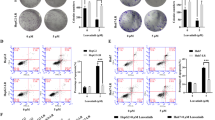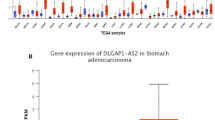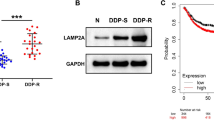Abstract
Background
Radiotherapy is widely employed in colorectal cancer (CRC) treatment but is often compromised by developed radioresistance. This study explored the mechanism of long non-coding RNA ovarian tumor domain containing 6B-antisense RNA1 (lncRNA OTUD6B-AS1) in CRC radioresistance through tripartite motif 16 (TRIM16).
Methods
CRC and non-cancerous tissues were collected and radioresistant CRC cells were established, with real-time quantitative polymerase chain reaction to determine gene expression in tissues and cells. Radioresistance was evaluated by cell counting kit-8 assay and immunofluorescence (γ-H2AX) and ferroptosis was tested by Western blot assay (ACSL4/GPX4) and assay kits (Fe2+/ROS/MDA/GSH). The association between ferroptosis and lncRNA OTUD6B-AS1-inhibited radioresistance was testified using ferroptosis inhibitor. The subcellular localization of lncRNA OTUD6B-AS1 was tested by the nuclear/cytoplasmic fractionation assay, with RNA immunoprecipitation assay to validate gene interactions. Rescue experiments were conducted to analyze the role of TRIM16 in CRC radioresistance.
Results
LncRNA OTUD6B-AS1 and TRIM16 were poorly expressed (P < 0.01) in CRC tissues and cells and further decreased (P < 0.01) in radioresistant CRC cells. OTUD6B-AS1 overexpression decreased cell survival (P < 0.01), increased γ-H2AX levels (P < 0.01), and elevated ferroptosis and oxidative stress (P < 0.01) after X-ray radiation. Ferroptosis inhibitor attenuated radioresistance (P < 0.01) caused by lncRNA OTUD6B-AS1 overexpression. LncRNA OTUD6B-AS1 stabilized TRIM16 mRNA via binding to HuR. TRIM16 knockdown reduced ferroptosis and increased radioresistance (P < 0.05).
Conclusion
OTUD6B-AS1 overexpression stabilized TRIM16 via binding to HuR and increased GPX4-mediated ferroptosis, thus attenuating CRC radioresistance. Our study provided a new rationale for the treatment of CRC.







Similar content being viewed by others
Data availability
The data that support the findings of this study are available from the corresponding author upon reasonable request.
References
Baidoun F, Elshiwy K, Elkeraie Y, Merjaneh Z, Khoudari G, Sarmini MT, et al. Colorectal cancer epidemiology: recent trends and impact on outcomes. Curr Drug Targets. 2021;22(9):998–1009.
Biller LH, Schrag D. Diagnosis and treatment of metastatic colorectal cancer: a review. JAMA. 2021;325(7):669–85.
Dariya B, Aliya S, Merchant N, Alam A, Nagaraju GP. Colorectal Cancer Biology, Diagnosis, and Therapeutic Approaches. Crit Rev Oncog. 2020;25(2):71–94.
Olivares-Urbano MA, Grinan-Lison C, Marchal JA, Nunez MI. CSC radioresistance: a therapeutic challenge to improve radiotherapy effectiveness in cancer. Cells. 2020;9(7):1651.
Lei G, Zhuang L, Gan B. Targeting ferroptosis as a vulnerability in cancer. Nat Rev Cancer. 2022;22(7):381–96.
Su Y, Zhao B, Zhou L, Zhang Z, Shen Y, Lv H, et al. Ferroptosis, a novel pharmacological mechanism of anti-cancer drugs. Cancer Lett. 2020;483:127–36.
Yuan H, Li X, Zhang X, Kang R, Tang D. Identification of ACSL4 as a biomarker and contributor of ferroptosis. Biochem Biophys Res Commun. 2016;478(3):1338–43.
Lei G, Zhang Y, Koppula P, Liu X, Zhang J, Lin SH, et al. The role of ferroptosis in ionizing radiation-induced cell death and tumor suppression. Cell Res. 2020;30(2):146–62.
Bao G, Xu R, Wang X, Ji J, Wang L, Li W, et al. Identification of lncRNA signature associated with pan-cancer prognosis. IEEE J Biomed Health Inform. 2021;25(6):2317–28.
Zhang W, Fang D, Li S, Bao X, Jiang L, Sun X. Construction and validation of a novel ferroptosis-related lncrna signature to predict prognosis in colorectal cancer patients. Front Genet. 2021;12:709329.
Cai Y, Li Y, Shi C, Zhang Z, Xu J, Sun B. LncRNA OTUD6B-AS1 inhibits many cellular processes in colorectal cancer by sponging miR-21-5p and regulating PNRC2. Hum Exp Toxicol. 2021;40(9):1463–73.
Xu Z, Jiang S, Ma J, Tang D, Yan C, Fang K. Comprehensive analysis of ferroptosis-related LncRNAs in breast cancer patients reveals prognostic value and relationship with tumor immune microenvironment. Front Surg. 2021;8:742360.
Yoon JH, Abdelmohsen K, Gorospe M. Posttranscriptional gene regulation by long noncoding RNA. J Mol Biol. 2013;425(19):3723–30.
Mandell MA, Saha B, Thompson TA. The tripartite nexus: autophagy, cancer, and tripartite motif-containing protein family members. Front Pharmacol. 2020;11:308.
Ruan L, Liu W, Yang Y, Chu Z, Yang C, Yang T, et al. TRIM16 overexpression inhibits the metastasis of colorectal cancer through mediating Snail degradation. Exp Cell Res. 2021;406(1): 112735.
Li JH, Liu S, Zhou H, Qu LH, Yang JH. starBase v2.0: decoding miRNA-ceRNA, miRNA-ncRNA and protein-RNA interaction networks from large-scale CLIP-Seq data. Nucleic Acids Res. 2014;42(Database issue):D92-7.
Livak KJ, Schmittgen TD. Analysis of relative gene expression data using real-time quantitative PCR and the 2(-Delta Delta C(T)) Method. Methods. 2001;25(4):402–8.
Wang W, Cheng X, Zhu J. Long non-coding RNA OTUD6B-AS1 overexpression inhibits the proliferation, invasion and migration of colorectal cancer cells via downregulation of microRNA-3171. Oncol Lett. 2021;21(3):193.
Tang X, Ding H, Liang M, Chen X, Yan Y, Wan N, et al. Curcumin induces ferroptosis in non-small-cell lung cancer via activating autophagy. Thorac Cancer. 2021;12(8):1219–30.
Priyanka P, Sharma M, Das S, Saxena S. The lncRNA HMS recruits RNA-binding protein HuR to stabilize the 3’-UTR of HOXC10 mRNA. J Biol Chem. 2021;297(2): 100997.
Lei G, Mao C, Yan Y, Zhuang L, Gan B. Ferroptosis, radiotherapy, and combination therapeutic strategies. Protein Cell. 2021;12(11):836–57.
Ye LF, Chaudhary KR, Zandkarimi F, Harken AD, Kinslow CJ, Upadhyayula PS, et al. Radiation-induced lipid peroxidation triggers ferroptosis and synergizes with ferroptosis inducers. ACS Chem Biol. 2020;15(2):469–84.
Ghafouri-Fard S, Hussen BM, Gharebaghi A, Eghtedarian R, Taheri M. LncRNA signature in colorectal cancer. Pathol Res Pract. 2021;222:153432.
Wang Y, Lu JH, Wu QN, Jin Y, Wang DS, Chen YX, et al. LncRNA LINRIS stabilizes IGF2BP2 and promotes the aerobic glycolysis in colorectal cancer. Mol Cancer. 2019;18(1):174.
Tang J, Yan T, Bao Y, Shen C, Yu C, Zhu X, et al. LncRNA GLCC1 promotes colorectal carcinogenesis and glucose metabolism by stabilizing c-Myc. Nat Commun. 2019;10(1):3499.
Zhou L, Jiang J, Huang Z, Jin P, Peng L, Luo M, et al. Hypoxia-induced lncRNA STEAP3-AS1 activates Wnt/beta-catenin signaling to promote colorectal cancer progression by preventing m(6)A-mediated degradation of STEAP3 mRNA. Mol Cancer. 2022;21(1):168.
Zhang M, Weng W, Zhang Q, Wu Y, Ni S, Tan C, et al. The lncRNA NEAT1 activates Wnt/beta-catenin signaling and promotes colorectal cancer progression via interacting with DDX5. J Hematol Oncol. 2018;11(1):113.
Wang L, Cho KB, Li Y, Tao G, Xie Z, Guo B. Long noncoding RNA (lncRNA)-mediated competing endogenous RNA networks provide novel potential biomarkers and therapeutic targets for colorectal cancer. Int J Mol Sci. 2019;20(22):5758.
Wang Z, Xia F, Feng T, Jiang B, Wang W, Li X. OTUD6B-AS1 Inhibits Viability, Migration, and Invasion of Thyroid Carcinoma by Targeting miR-183–5p and miR-21. Front Endocrinol (Lausanne). 2020. https://doi.org/10.3389/fendo.2020.00136.
Wang G, Zhang ZJ, Jian WG, Liu PH, Xue W, Wang TD, et al. Novel long noncoding RNA OTUD6B-AS1 indicates poor prognosis and inhibits clear cell renal cell carcinoma proliferation via the Wnt/beta-catenin signaling pathway. Mol Cancer. 2019;18(1):15.
Li PP, Li RG, Huang YQ, Lu JP, Zhang WJ, Wang ZY. LncRNA OTUD6B-AS1 promotes paclitaxel resistance in triple negative breast cancer by regulation of miR-26a-5p/MTDH pathway-mediated autophagy and genomic instability. Aging (Albany NY). 2021;13(21):24171–91.
Kong S, Xue H, Li Y, Li P, Ma F, Liu M, et al. The long noncoding RNA OTUD6B-AS1 enhances cell proliferation and the invasion of hepatocellular carcinoma cells through modulating GSKIP/Wnt/beta-catenin signalling via the sequestration of miR-664b-3p. Exp Cell Res. 2020;395(1): 112180.
Hou H, Yu R, Zhao H, Yang H, Hu Y, Hu Y, et al. LncRNA OTUD6B-as1 induces cisplatin resistance in cervical cancer cells through up-regulating cyclin D2 via miR-206. Front Oncol. 2021;11: 777220.
Santivasi WL, Xia F. Ionizing radiation-induced DNA damage, response, and repair. Antioxid Redox Signal. 2014;21(2):251–9.
Sharma A, Singh K, Almasan A. Histone H2AX phosphorylation: a marker for DNA damage. Methods Mol Biol. 2012;920:613–26.
Wang Y, Yang T, Han Y, Ren Z, Zou J, Liu J, et al. lncRNA OTUD6B-AS1 exacerbates As(2)O(3)-induced oxidative damage in bladder cancer via miR-6734–5p-mediated functional inhibition of IDH2. Oxid Med Cell Longev. 2020. https://doi.org/10.1155/2020/3035624.
Peng WX, Koirala P, Zhang W, Ni C, Wang Z, Yang L, et al. lncRNA RMST enhances DNMT3 expression through Interaction with HuR. Mol Ther. 2020;28(1):9–18.
Tian H, Lian R, Li Y, Liu C, Liang S, Li W, et al. AKT-induced lncRNA VAL promotes EMT-independent metastasis through diminishing Trim16-dependent Vimentin degradation. Nat Commun. 2020;11(1):5127.
Roshanazadeh MR, Adelipour M, Sanaei A, Chenane H, Rashidi M. TRIM3 and TRIM16 as potential tumor suppressors in breast cancer patients. BMC Res Notes. 2022;15(1):312.
Nagy Z, Cheung BB, Tsang W, Tan O, Herath M, Ciampa OC, et al. Withaferin A activates TRIM16 for its anti-cancer activity in melanoma. Sci Rep. 2020;10(1):19724.
Li Q, Chen K, Dong R, Lu H. LncRNA CASC2 inhibits autophagy and promotes apoptosis in non-small cell lung cancer cells via regulating the miR-214/TRIM16 axis. RSC Adv. 2018;8(71):40846–55.
Xie T, Tan M, Gao Y, Yang H. CRABP2 accelerates epithelial mesenchymal transition in serous ovarian cancer cells by promoting TRIM16 methylation via upregulating EZH2 expression. Environ Toxicol. 2022;37(8):1957–67.
Huo X, Li S, Shi T, Suo A, Ruan Z, Yao Y. Tripartite motif 16 inhibits epithelial-mesenchymal transition and metastasis by down-regulating sonic hedgehog pathway in non-small cell lung cancer cells. Biochem Biophys Res Commun. 2015;460(4):1021–8.
Wang Y, Wu Y, Xie S. CircPTK2 inhibits cell cisplatin (CDDP) resistance by targeting miR-942/TRIM16 axis in non-small cell lung cancer (NSCLC). Bioengineered. 2022;13(2):3651–64.
Wang N, Zhang T. Downregulation of microRNA-135 promotes sensitivity of non-small cell lung cancer to gefitinib by targeting TRIM16. Oncol Res. 2018;26(7):1005–14.
Sutton SK, Carter DR, Kim P, Tan O, Arndt GM, Zhang XD, et al. A novel compound which sensitizes BRAF wild-type melanoma cells to vemurafenib in a TRIM16-dependent manner. Oncotarget. 2016;7(32):52166–78.
Yao J, Xu T, Tian T, Fu X, Wang W, Li S, et al. Tripartite motif 16 suppresses breast cancer stem cell properties through regulation of Gli-1 degradation via the ubiquitin-proteasome pathway. Oncol Rep. 2016;35(2):1204–12.
Funding
This work was supported by the Special Fund of Foshan Summit Plan (No. 2019C020) and the Construction Funds for High-level Medical Key Specialty Projects in Foshan during the 14th Five Year Plan Period (No. 0660215).
Author information
Authors and Affiliations
Contributions
Conceptualization: ZZ, BY, YL; Formal analysis and investigation: ZZ, WL; Writing—original draft preparation: ZZ, WL, JD; Writing—review and editing: ZZ, WJ. All authors read and approved the final manuscript.
Corresponding authors
Ethics declarations
Conflict of interest
The authors have declared no conflicts of interest.
Ethical approval
This study conformed to the Declaration of Helsinki and got the approval of the Ethics Committee of Jinling Hospital, the First School of Clinical Medicine, Southern Medical University.
Informed consent
Each patient signed the written informed consent.
Additional information
Publisher's Note
Springer Nature remains neutral with regard to jurisdictional claims in published maps and institutional affiliations.
Rights and permissions
Springer Nature or its licensor (e.g. a society or other partner) holds exclusive rights to this article under a publishing agreement with the author(s) or other rightsholder(s); author self-archiving of the accepted manuscript version of this article is solely governed by the terms of such publishing agreement and applicable law.
About this article
Cite this article
Zhang, Z., Ye, B., Lin, Y. et al. LncRNA OTUD6B-AS1 overexpression promoted GPX4-mediated ferroptosis to suppress radioresistance in colorectal cancer. Clin Transl Oncol 25, 3217–3229 (2023). https://doi.org/10.1007/s12094-023-03193-7
Received:
Accepted:
Published:
Issue Date:
DOI: https://doi.org/10.1007/s12094-023-03193-7




